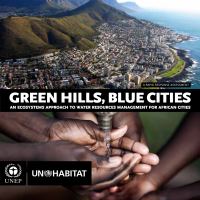

34
PROBLEMS WITH GRAHAMSTOWN’S WATER
SUPPLY AND SANITATION
The goal of ensuring sustainable and reliable water supply
and adequate sanitation in Grahamstown is faced with several
challenges, including:
• The possibility of substantial reductions in rainfall by the end
of this century like most of Southern Africa (IPCC 2007).
• Historical inequities in service delivery between
Grahamstown East and West, with the previously white West
receiving comprehensive services, and paying for them,
while much delayed and often sub-standard services in the
East are combined with a historical reluctance and inability to
pay. A local councillor wrote in December 2006 “…the sum
of unpaid accounts has steadily increased such that it is now
in excess of one year’s operating budget, which has virtually
eliminated the capacity of the municipality to purchase new
equipment and squeezes the maintenance budget to about
6 per cent of the operating budget” (quoted in Maki and
Mullins 2007).
• Outdated and unreliable infrastructure, which has not been
maintained adequately. The pumps and pipelines from
Howison’s Poort to Waainek were installed in 1931 and
could provide 2 050 litres per minute up the 454 m lift to
Waainek, which was then the highest lift in the country. In
2010 Howison’s Poort was empty, and when it refilled in
December, the pumps, unused for several months, failed to
operate and had to be repaired.
• Inadequate technical capacity among municipal employees.
ENVIRONMENTAL IMPACTS AND
SUSTAINABILITY APPROACHES
The provision of bulk water, and the treatment and disposal
of wastewater from a community of more than one hundred
thousand will necessarily have environmental impacts. The
regulation, storage and abstraction of water from local rivers
disrupt their flow and geographical continuity, with severe
consequences to the riverine biodiversity. The disposal of even
treated water has consequences for the downstream water
quality, in terms of increased salinity and nutrients. In addition
to these consequences of urban development, Grahamstown’s
water footprint is partly responsible for environmental
problems in a wider geographical area. The Orange/Great
Fish water transfer, on which Grahamstown relies for much

















